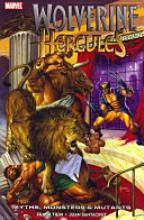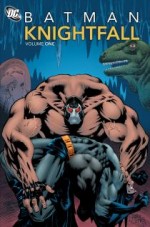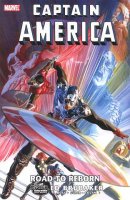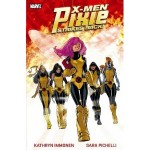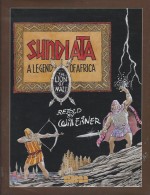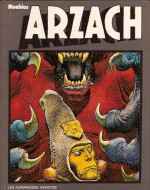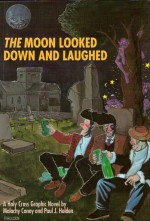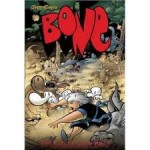
By Jeff Smith (Cartoon Books)
ISBN: 978-0-96366-9-095-4
Jeff Smith burst out of relative obscurity in 1991 and changed the comics-reading landscape with his enchanting all-ages comic-book Bone. The compelling black and white saga captivated the market and prospered at a time when an endless procession of angst-ridden, steroid-breathed super-vigilantes and implausibly clad “Bad-Grrls†came and went with machine-gun rapidity.
Born in Pennsylvania and raised in Ohio, Smith avidly absorbed the works of Carl Barks, Charles Schultz and especially Walt Kelly from an early age, and purportedly first began producing the adventures of his Boneville creations at age ten.
Whilst attending Ohio State University he created a prototype strip for the College newspaper: ‘Thorn’ was another early incarnation of his personal universe and a valuable proving ground for many characters that would eventually appear in Bone. A high school classmate became a Disney animator and Smith subsequently gravitated to the field before striking out on his own, having mastered the graceful gentle slapstick timing and high finish style which typifies his art style.
He founded Cartoon Books to self-publish 55 delightful black and white issues: a fantasy-quest yarn that owed as much to Tex Avery as J.R.R. Tolkien, as well as his personal holy trinity, Barks, Schultz & Kelly. The thrilling and fantastically funny saga progressed at its own unique pace between 1991 and 2004 and since then has been collected into nine volumes from Cartoon Books (with two further collections of prequels and side tales), reissued in colour by Scholastic Books and even reprinted in Disney Adventures magazine.
At series’ end, Smith issued a monumental one volume compilation (more than 1300 black and white pages) which Time magazine dubbed “the best all-ages graphic novel yet published†and one of the “Top Ten Graphic Novels of All Time.â€
Smith has won many awards including 11 Harveys and 10 Eisners. In 2011, a spectacular 20th anniversary full-colour edition of the Brobdingnagian single volume was released, stuffed with extras and premiums. If you’ve got the dough, that’s the book to shoot for…
As you can see there are plenty of versions to opt for but – purist that I am – I’ve plumped for the original Cartoon Books collection where the action commences in Out of Boneville, which re-presents the first six episodes.
Fone Bone is a strange, amorphous, yet affably decent little guy, a thematic blend of Mickey Mouse and Asterix who had been run out of the town of Boneville along with his tall and not-so-bright cousin Smiley Bone. Well to be exact they weren’t, but their dastardly, swindling cousin Phoncible P. “Phoney†Bone was, due to the sort of financial and political irregularities, misdemeanours and malfeasances that bring down presidents – and he only was running for Mayor at the time…
After an incredibly journey the trio were separated and ended up in Lost Valley: an oasis of pastoral beauty hidden from the rest of the world. Along the way Bone was adopted by a dragon he doesn’t believe in, stalked by ghastly rat monsters and befriended by a talking leaf-insect (like a stick insect but flat, not long – and very, very chatty) called Ted.
After a harsh winter living wild in the deep forest he met the beauteous and oddly compelling human girl Thorn. It was Crush-at-First-Sight and he happily accepted an offer to stay with her and grandmother Rose Ben until he could find his lost cousins. He soon came to regret it when Phoney finally turned up and started his old tricks again…
Phoney’s insatiable drive to steal, cheat and fake a buck made life pretty uncomfortable for the besotted Fone Bone, but real trouble was actually brewing in the deep woods where an ancient evil had awoken, driving the stupid, stupid rat creatures who infested the place into a frenzy.
An incredibly old, cold war was heating up again and for the humans of nearby Barrelhaven village the stakes couldn’t be higher. The dark creatures and night-haunts were waiting for the advent of their prophesied one – a small bald creature with a star on its chest – remarkably similar to the one on Phoney’s shirt…
When the assembled horror-hordes attacked the cottage their putative chosen one was long gone…
Phoney had scented money and moved to the hamlet in search of easy marks and, as Thorn and Fone raced to warn the villagers that the beasts had risen, Gran’ma stayed behind to battle the rat things. When Bone’s “imaginary†dragon rescued the fleeing pair, they retraced their frantic steps to find the feisty old biddy had survived and overcome her attackers. Moreover, Rosie and the Dragon were old acquaintances…
As the Dragon returned to the deep woods the humans (and Bone) leave the wrecked cottage and relocate to Barrelhaven, where they find Smiley has been all along, serving drinks in the local tavern. Phoney is there too – working off a tremendous bar-tab and looking to make some easy, preferably illicit cash…
This second stunning compilation collects issues #7-12 of the comicbook and also includes the contents of premium special Wizard Presents Bone #13½; opening with Thorn and Fone enjoying the bucolic delights of ‘The Spring Fair’.
Our diminutive love-struck hero is in heaven as he strolls with the oblivious Thorn but when her attention is diverted by hunky young travelling honey-seller Tom, Bone gets into a fight with the peddler and the girl, before storming off to find his own sticky treat by raiding a wild bee’s nest in the forest – with calamitous and hilariously painful results.
Phoney meanwhile is planning to fleece the villagers with a betting scam. For years the uncannily robust and unbeatable Gran’Ma has won the annual Great Cow Race (which seemingly consists of stampeding a herd and outrunning them to a finish line) and the riotous event has become her very own yearly moment of glory.
Now the wily rogue and his gullible patsy Smiley are taking bets against her, whilst disseminating disinformation that she is ailing and past her prime. All the smart money – chickens, goats, sheep etc. – is on a dark horse “Mystery Cowâ€â€¦
And with the entire village constantly asking about her health, old Rose begins to worry and doubt herself…
‘The Map’ finds Phoney’s betting booth doing a roaring trade with all bets on the as yet unseen Mystery Cow, when the battered, bruised and mightily stung Bone comes by. Appalled to see his cousin up to his old tricks, the honey-dipped hero confronts Phoney and discovers the whole plan: even though the entire village has put all their valuables on the outsider, Gran’Ma will easily win the Great Race since the enigmatic bovine challenger will be Smiley in a cow suit…
Thorn is dreaming, seeing again a time past when mysterious cloaked figures and dragons met in a cave and considered the inevitable return of a dark and deadly menace. Sharing the dream with Bone she remembers an old chart Bone found in the Great Desert and which first led him to safety in the valley … a map she drew whilst a toddler in that cave of dragons…
‘The Mystery Cow’ opens on the day of the race, and tension in Barrelhaven is at a sullen fever pitch. Rose’s confidence is still fragile though and tavern owner Lucius – who is sweet on her – finally accedes to Phoney’s constant haranguing and agrees to bet the entire business on the race. The rest of the punters are nervous though. They’ve wagered all their worldly goods against Gran’Ma on a critter no one has ever seen and Lucius suggests that maybe they should check on it…
Given a noon deadline to produce the unbeatable cow for the town’s perusal, duplicitous, greedy Phoney is starting to see some flaws in his infallible plan and Thorn too gets a moment of cold realisation when Tom blows her off for a more pliable companion…
Downhearted, Bone has retired to the woods to read Moby Dick, but after a heart-to-heart with Ted, determines to bare his soul to Thorn in a love poem.
His mood is soon lost though when a couple of Rat Creatures turn up, wondering aloud if he is fair game or the “Small Mammal†they aren’t allowed to eat as elsewhere, with noon approaching, Phoney pulls a bold stunt and again fools the oafish villagers with the crazed, unbeatable ferocity of his Mystery Cow…
‘The Great Cow Race’ is about to start and udder-draped Smiley has his instructions to finish behind Gran’Ma, but Phoney’s greed gets the better of him when he circles back to his booth to find Lucius at last ready to bet the bar. Unfortunately the doughty old buzzard wants to place it on Rose to win – and the odds are now 100 to 1…
With vivid memories of his last tar-and-feathering, the bovine bookmaker hurtles to intercept Smiley and tell him to win at all costs and as the herd thunders by with Rose in the lead, Bone appears, running his own desperate race. At his milky heels are the two starving and stupid, stupid Rat Creatures.
Sadly where there are a couple, inevitably the entire ravenous horde soon follows – and they do, perfectly and painfully intermingling with the frantic racers just as the finish line comes into sight…
‘Retribution’ opens with the victorious Gran’Ma, Lucius and Thorn riding a cartload of building supplies back to their devastated cottage. Hidden in the back are the Bone cousins, Phoney only gradually recovering from the rough-and-ready justice he has received from the incensed villagers.
With Smiley teasing Bone about the dragon only he has seen it’s a slow and anxious journey through the dark woods, since the Rat Creatures all vanished into the forest after the race melee ended. Indeed many ancient eyes, both friendly and inimically hostile, are following the party’s progress…
As the two starving rat things who started the debacle lay low and uproariously consider the upside of quiche as opposed to raw flesh, the repair squad arrives at the cottage and begins work, whilst in the background Lucius and Rose discuss the real importance of what’s been happening, especially for Thorn…
Following a delightful poetic frolic from Bone’s frisky friends the possum kids, the book ends on a funny if foreboding note as the bombastic Lucius and ham-fisted, half-witted Smiley learn a little more about each other whilst painfully rebuilding Gran’Ma’s house ‘Up on the Roof’…
I’ve talked a lot about the influences that informed this wonderful series and there’s one more that cannot be ignored: if you squint your eyes just right you can see the charm-adjacent convolutions of Bill Watterson’s Calvin (see The Essential Calvin and Hobbes. No, really. Do. It’s utterly wonderful and so are all the other collections) sneaking in to further flavour this astounding, raucous, beguiling, child-friendly extravaganza…
Bone is a truly perfect comic tale and one that appeals to kids and adults equally. Already it is in the rarefied rank starring Tintin, Pogo, Rupert Bear, Little Nemo and the aforementioned and cherished works of Schultz, Kelly and Barks. It is only a matter of time before it breaks out of the comic club completely and becomes kin to the likes of Wind in the Willows, Alice in Wonderland, the Moomins and Oz.
If you have kids or can still think and feel like one you must have these books…
© 1995, 1996 Jeff Smith. All rights reserved.


